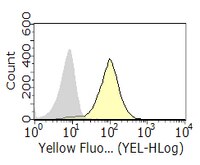MABF919 Sigma-AldrichAnti-Ly108/Slamf6 Antibody, clone 3E11
Anti-Anti-Ly108/Slamf6 Antibody, clone 3E11 , Cat. No. MABF919, is a highly specific rat monoclonal antibody that targets Ly108/Slamf6 and has been tested in Flow Cytometry, Function Assay, Immunoprecipitation, and Western Blotting.
More>> Anti-Anti-Ly108/Slamf6 Antibody, clone 3E11 , Cat. No. MABF919, is a highly specific rat monoclonal antibody that targets Ly108/Slamf6 and has been tested in Flow Cytometry, Function Assay, Immunoprecipitation, and Western Blotting. Less<<Recommended Products
Overview
| Replacement Information |
|---|
Key Spec Table
| Species Reactivity | Key Applications | Host | Format | Antibody Type |
|---|---|---|---|---|
| M | FC, IP, WB, Function Assay | R | Purified | Monoclonal Antibody |
| References |
|---|
| Product Information | |
|---|---|
| Format | Purified |
| Presentation | Purified rat monoclonal IgG2a in buffer containing PBS without preservatives. |
| Quality Level | MQ100 |
| Physicochemical Information |
|---|
| Dimensions |
|---|
| Materials Information |
|---|
| Toxicological Information |
|---|
| Safety Information according to GHS |
|---|
| Safety Information |
|---|
| Packaging Information | |
|---|---|
| Material Size | 100 µg |
| Transport Information |
|---|
| Supplemental Information |
|---|
| Specifications |
|---|
| Global Trade Item Number | |
|---|---|
| Catalogue Number | GTIN |
| MABF919 | 04054839034497 |
Documentation
Anti-Ly108/Slamf6 Antibody, clone 3E11 SDS
| Title |
|---|
Anti-Ly108/Slamf6 Antibody, clone 3E11 Certificates of Analysis
| Title | Lot Number |
|---|---|
| Anti-Ly108/Slamf6, clone 3E11 -Q2726978 | Q2726978 |







